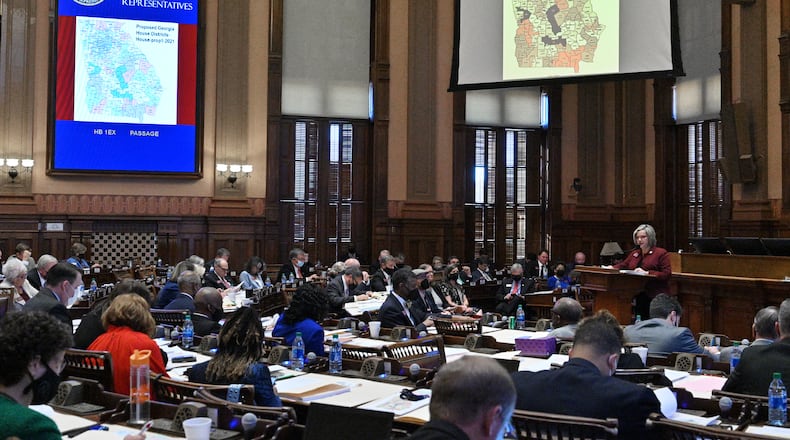The Georgia House voted Wednesday to remap the state’s 180 districts in a way that protects a shrinking Republican majority and adds new metro Atlanta districts to accommodate population growth.
The 99-79 vote, almost entirely along party lines, clears the way for the General Assembly to finish redistricting itself within days, a rapid process that began a week ago. The state Senate passed its maps on Tuesday, and Republican leaders will soon consider how to draw Georgia’s congressional lines as they attempt to gain seats.
Redistricting is required every decade to ensure each district has equal populations after Georgia added 1 million residents, most of them in metro areas. As a result, cities and suburban areas that lean Democratic will gain representation, while rural areas that tend to support Republicans will lose a few seats.
Under the House map approved Wednesday, the chamber’s Republican majority could lose six seats after next year’s elections. The map creates 97 districts that lean Republican and 83 that trend toward Democrats, according to an analysis by The Atlanta Journal-Constitution. There are currently 103 Republicans and 77 Democrats in the House.
“This is a reflection of the growth in minority populations in the state of Georgia, our state’s increased diversity and compliance with the Voting Rights Act,” said state Rep. Chuck Efstration, a Republican from Dacula. “This is a good map.”
Democrats objected to the redistricting plan, saying it had been quickly pushed through the legislative process with district lines that reduce their representation. Georgia is closely split between Democrats and Republicans in statewide elections, but the state House map continues to give the GOP an advantage.
“The people of Georgia deserve more than a magic show of smoke and mirrors,” said state Rep. Carolyn Hugley, a Democrat from Columbus. “Republicans have ignored the will of Georgia voters in drawing their Statehouse map proposal. It minimizes the political power of the people of Georgia and ignores the fact that Georgia is equally divided politically.”
Credit: Gina.Wright
Credit: Gina.Wright
The mapmaking process picks winners and losers, with some representatives drawn into districts that favor their opponents and others forced to face members of their own party.
For example, Republican state Rep. Philip Singleton’s new district would favor Democrats in next year’s elections because it will extend north of Coweta County into Fulton County. Singleton has been a staunch critic of Republican House Speaker David Ralston, and he’ll now face a difficult path to reelection.
A few representatives were drawn into the same districts as incumbents, meaning only one will remain after next year’s elections. Only one of those pairings forces a contest between a Republican and a Democrat, when Republican Rep. Gerald Greene of Cuthbert would face Democratic Rep. Winfred Dukes of Albany.
“If you allow your voice to be silenced, or you willingly submit your voice to a select few, you are complicit in the destruction of our republic,” said Singleton, a Republican who voted against the map. “I want everyone in this room to have an equal voice.”
Democrats said Georgia’s districts should have been crafted in a way that kept more communities unified under one representative and empowered people of color to represent them. Members of the House are about 67% white in a state where white people make up about half of the population.
Credit: Hyosub Shin/AJC
Credit: Hyosub Shin/AJC
“The people of Georgia deserve better. The people of Georgia demanded a fair and transparent redistricting process,” said Minority Leader James Beverly, a Democrat from Macon. “What they got instead was a rushed and secretive process.”
The House map introduces several opportunities for Democrats to make gains, primarily in newly formed districts in metro Atlanta, seats where there are no incumbents. There are two new districts in Cobb County, two in Gwinnett County, one in Fulton County and one in Rockdale County.
Each House district in the state will represent about 59,500 residents. The House map now advances to the state Senate for further consideration, a day after the Senate approved a map for its 56 districts.
“Not everybody’s going to be happy,” said Ralston, a Republican from Blue Ridge. “Not all the Republicans are going to be happy. And that’s the case with every piece of legislation that we pass, but we have done the best we can.”
After the General Assembly finishes redistricting itself, maps for Georgia’s 14 congressional districts will be introduced.
Republicans currently hold an 8-6 majority in Georgia’s U.S. House delegation, and the GOP is trying to regain a seat currently held by Democrat Lucy McBath, who represents parts of Cobb, DeKalb and Fulton counties. A proposal by state Senate leaders would move more conservative Forsyth County into her district, but the House hasn’t yet released its congressional plan.
— Staff writer Maya T. Prabhu contributed to this article.
About the Author
Keep Reading
The Latest
Featured






